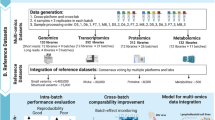Abstract
Expression microarrays have great potential for clinical use but variability of the results represents a challenge for reliable practical application. The amount of fluorescent dye used in microarray experiments is a significant source of variability that has not been systematically studied. Here we demonstrate that the quantity of Cy3 dye affects microarray results performed on tumor specimens. Signal-to-noise ratios and coefficients of variation are significantly improved by increasing Cy3 to 150–180 pmol, but any further increase does not improve the data. In conclusion, optimal amounts of dye reduce variability and improve reliability of expression microarray experiments.
Similar content being viewed by others
References
Van De Vijver, M. J., He, Y. D., Van’ T Veer, Y. D., et al. (2002) A gene-expression signature as a predictor of survival in breast cancer. N. Engl. J. Med. 347, 34–42.
Tan, P. K., Downey, T. J., Spitznagel E. L. Jr., et al. (2003) Evaluation of gene expression measurements from commercial microarray platforms. Nucleic Acids Res. 31, 5676–5684.
Jarvinen, A. K., Hautaniemi, S., Edgren, H., et al. (2004) Are data from different gene expression microarray platforms comparable? Genomics 83, 1164–1168.
’T Hoen, P. A. C., de Kort, F., van Ommen, G. J. B., and den Dunnen, J. T. (2003) Fluorescent labelling of cRNA for microarray applications. Nucleic Acids Res. 31, e20.
Hughes, T. R., Mao, M., Jones, A. R., et al. (2001) Expression profiling using microarrays fabricated by an ink-jet oliginucleotide synthesizer. Nat. Biotechnol. 19, 342–347.
Zhao, H., Hastie, T., Whitfield, M. L., Borresen-Dale, A. L., and Jeffrey, S. S. (2002) Optimization and evaluation of T7 based RNA linear amplification protocols for cDNA microarray analysis. BMC Genomics 3:J31.
Jia, M. H., Larossa, R. A., Lee, J. M., et al. (2000) Global expression profiling of yeast treated with an inhibitor of amino acid biosynthesis, sulfometuron methyl. Physiol. Genomics 3, 83–92.
Yang, I. V., Chen, E., Hasseman, J. P., et al. (2002) Within the fold: assessing differential expression measures and reproducibility in microarray assays. Genome Biol. 3, 1–13.
Naderi, A., Ahmed, A. A., Barbosa-Morais, N. L., Aparicio, S., Brenton, J. D., and Caldas, C. (2004) Expression microarray reproducibility is improved by optimising purification steps in RNA amplification and labelling. BMC Genomics 5, 9.
Author information
Authors and Affiliations
Corresponding author
Rights and permissions
About this article
Cite this article
Naderi, A., Ahmed, A.A., Wang, Y. et al. Optimal amounts of fluorescent dye improve expression microarray results in tumor specimens. Mol Biotechnol 30, 151–154 (2005). https://doi.org/10.1385/MB:30:2:151
Issue Date:
DOI: https://doi.org/10.1385/MB:30:2:151




